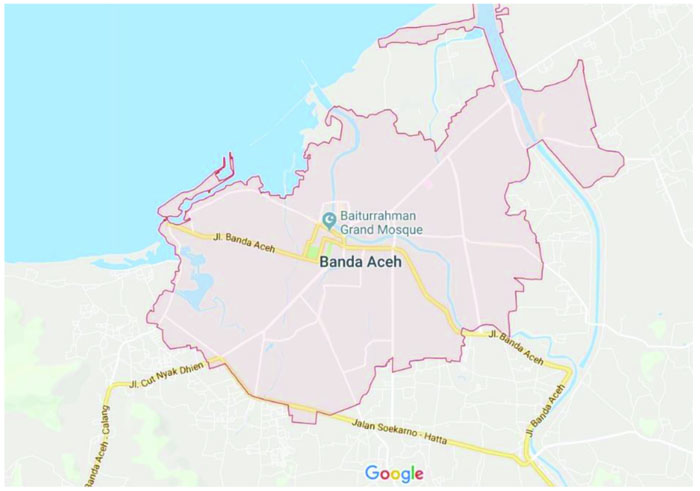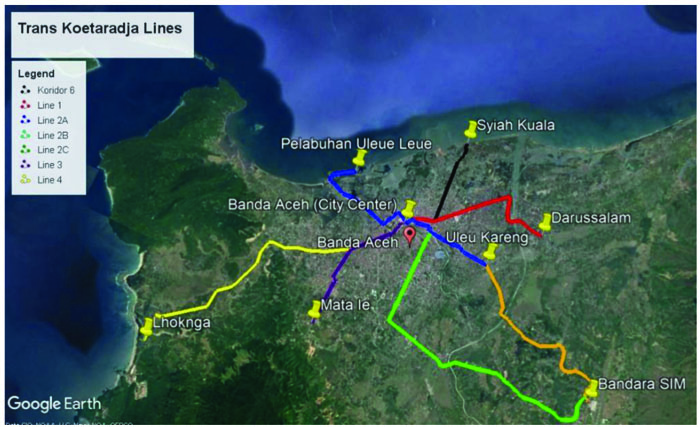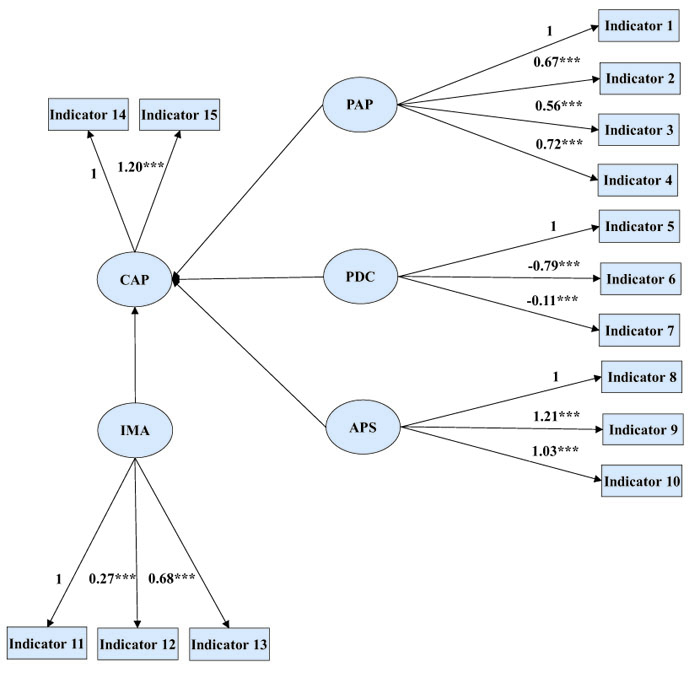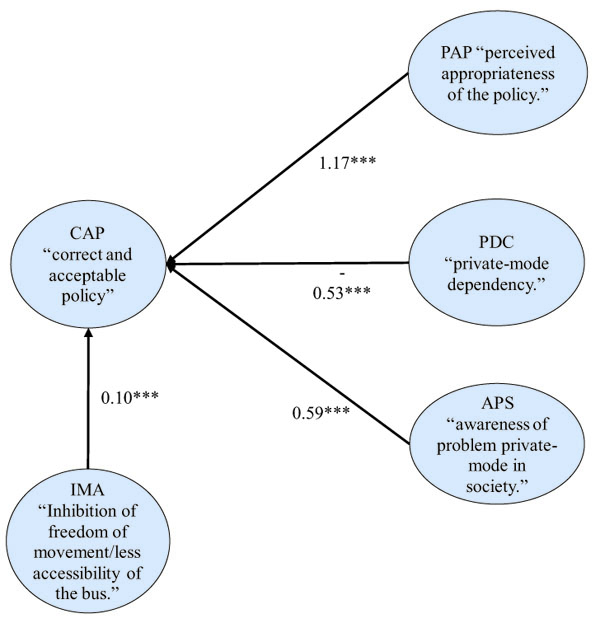All published articles of this journal are available on ScienceDirect.
Analysis on Public’s Response Toward Bus Reform Policy in Indonesia Considering Latent Variables
Abstract
Background:
Public Transport (PT) is commonly recognized as a valid transport policy to reduce car and motorcycle users in many developing countries. In emerging countries such as Indonesia, a city like Banda Aceh has not been away from the influences of impecunious public transportation services such as insufficient quality of services. The need for public transport reforms in achieving efficiency and sufficiency is under consideration by the Government as a way to mitigate severe private mode dependency. Therefore, Stated Preference (SP) survey was conducted in Banda Aceh, Indonesia, where the so-called bus reform policy Trans Koetaradja runs under trial as a case study. This investigation evaluated Banda Aceh citizens’ intentions to Trans Koetaradja bus reform policy in terms of the public approval.
Methods:
The questionnaires were distributed to the public within three lines of Trans Koetaradja. Utilizing psychometric data collected from SP survey, we constructed four factors representing psychological determinants (i.e., appropriateness of the policy, private mode dependency, the consciousness of problem private mode in society, and inhibition of freedom of movements). Due to the characteristics of the methods for evaluating public’ intentions, we retain that this kind of unobserved variable analysis could be accomplished by applying multivariate latent variable modeling.
Aims:
This work aims to propose a Structural Equation Modeling of the Confirmatory Factor Analysis (SEM-CFA) for analyzing the effects of citizens intents related to an individuals’ indicators of the psychological factors that might abridge the judgments about numerous characteristics towards the bus reform policy.
Results:
The empirical findings show that some latent factors offer explanatory power for bus reform policy acceptance. Latent variables, including “perceived appropriateness of the policy” and “awareness of problem private mode in society” appear to be the most significant direct causes leading to the acknowledgment of the effect of the acceptance of the proposed policy.
Conclusion:
However, the effect of latent variables of “private mode dependency” and “inhibition of freedom of movement/less accessibility of the bus” reveals negative determinants to the acceptance of the policy.
1. INTRODUCTION
Banda Aceh, the capital of Aceh Province, is one of the medium sized cities with a population around 259,913 inhabitants [1]. As with many medium cities in Indonesia, to date, the city has been urbanizing speedily and has experienced considerable changes in growing economy and motorization. Modern motorized society faces several externalities due to traffic congestion such as unwarranted travel times, air pollution, unnecessary energy consumption, and driver frustration [2]. These congestion-manifested problems have also extended to the city of Banda Aceh, as extraordinary growth in motorization has taken place. Accordingly, the government of Aceh needs to act strategically to deal with motorization related problems.
Like many other rapidly growing cities in Indonesia, the city center of Banda Aceh has not run away from the influences of impecunious public transportation services such as insufficient quality of services, lack of safety for passengers, and inefficient capacity. Moreover, the city's public transportation is essentially served by so-called vans “labi-labi” and small buses with capacities of about 10 and 35 passengers, respectively. Furthermore, the current public transportation system is unsuccessful in coping with the growing spatial and demographics of the city. People have difficulties in accessing the basic requirements of transportation services. Admittance to quality public transportation services is exceptionally problematic, and this is an essential problem for residents especially low-income commuters’ needs for adequate access to public transport as basic municipal facilities.
To deal with the poor public transport services, the government has designed a proposal for the bus reform policy. That is, the government aims to replace conventional public transport into a more convenient bus system by changing technology and system operation. The bus reform called“Trans Koetaradja” is a new technology and bus system with a capacity of 60 passengers equipped with an air conditioner, providing more comfort to the passengers. The needs of public transport reforms are to achieve efficiency and sufficiency. However, in particular for developing countries such as Indonesia, public transport reforms have to meet other goals namely affordability, accessibility, and convenience.
Trans Koetaradja now is under trial runs, a free-of-charge service is applied within running corridors. If this proposed bus system would succeed, then the Bus Rapid Transit (BRT) system will be applied in the next planning step. Studies have shown that bus reform policy such as BRT has appeared as a cost-effective public transport alternative with noteworthy possibility for Jakarta [3, 4]. Besides, providing appropriate public transportation will deliver the effectiveness in reducing congestion related problem such as cutting down CO2 emissions, increasing the efficiency of fuel use, as well as making the society more equitable regarding mobility [5, 6]. Approaches to developing public services that would perform well could be taken into consideration in the comprehensive transportation planning policy [7]. Encouraging and improving public transportation could get more extensive attention and become a critical issue in developing countries. Furthermore, Fujii and Van [7] also recommended that the solution can be provided by combining “hard policy” measures, such as improving the quality services, and the “soft policy” measures, such as changing travel behavior by adopting mobility management.
It is observed that travel behavior changes are substantially related to psychological motivations. In this regards, there are countless studies attempting to comprehend the subjective intentions that affect the public in supporting specific transport policies. For instance, Eriksson et al. [8] verified that the individual’s subjective indicators related to problem awareness, policy fairness, and perceived effectiveness are documented as a vital aspect distressing the acceptability of transport pricing proposal. Furthermore, Fujii [9] and Gärling et al. [10] established that the emotional intention related to infringement of freedom, policy fairness, problem awareness, and perceived effectiveness has directly and indirectly contributed to the acceptance of the policy. These psychological aspects indicate that a wide range of psychological motivations explain the acceptability of transport policies.
In the context of developing country perspectives, Sugiarto et al. [11-13] scrutinized citizen’s choice behaviors by taking into consideration observed and unobserved variables. They revealed that unobserved factors, namely recognition to the proposed policy, the fairness of the system, awareness of the congestion-related problems and inhibition of freedom of movement have significant encouragement of acceptance determinant to transport pricing measures in Jakarta. Moreover, Joewono and Kubota [14] revealed that there is a substantial association between global satisfaction and devotion to use public transport services. An investigation by Fujii and Van [7] found that the psychological determinants to the habit of using bus system in Ho Chi Minh City (HCMC) city were unobserved factors such as moral concerns and the perceiving of the service quality, and they concluded that grounded on psychological variables, the mobility management actions may well be functional in encouraging people to use the bus.
Given the above background, two hypotheses were made in this study. We hypothesized that (1) perceived appropriateness of the policy and awareness of the problem of private mode of transportation would have a positive effect on their intentions to support the proposed policy; (2) determinant of private mode dependency and inhibition of freedom of movement/less accessibility of the bus would have an adverse consequence on such intentions. Consequently, this study assessed the citizens’ subjective response to the acceptance from the public regarding proposed Trans Koetaradja. Revealing travel behavior of private mode users using psychological approaches is crucially important to develop better mobility management in private mode dependence city. With this, an experimental investigation of citizen’s intention has been undertaken to adopt the bus reform policy. This effort might be of precise assistance in designing a more efficient policy for the advancement of a bus reform policy by capturing some of the intelligent communication strategies for the development of mobility management. To conclude, a healthier thoughtful of local characteristics approach, such as understanding the effect of motorized traffic in a particular effect of motorcyclists on the demand of trip, is essential for successful transport policy measures for the betterment of the society [15, 16].
2. METHODS
2.1. Sample
The Stated Preference (SP) experimental of Louviere et al. [17-19] has been implemented in our study. The SP method is extensively used in transport modeling particularly to analyze travel behaviors [20-22]. The SP was employed to design a questionnaire survey in this work. The target respondents were commuters, commercial visitors and employees within Trans Koetaradja lines. It should be noted that the questionnaire was distributed among the bus riders and people who live in the surrounding area within the bus lines. The proportion of the targeted samples of respondents can be seen in Table (1). The Trans Koetaradja runs on trial within the city of Banda Aceh, as shown in Fig. (1) The target area of this study was line number 1 (red), 3 (dark blue), and 4 (yellow) of Trans Koetaradja, as shown in Fig. (2). Above mentioned bus lines are major urban roads that experience traffic congestion, particularly during peak hours.
A paper-pencil based questionnaire survey based on the direct interview was conducted in late 2017 and early 2018 in Banda Aceh. The questionnaires were distributed to 870 participants, and a total of 450 questionnaires were valid and used in this study. The preliminary analysis of the data set has been done and published in the previous study [18, 19]. Table (1) gives our experimental information such as time of collecting data, survey location, sampling number and distribution of the samples.

| Description | Detail |
|---|---|
| Time of survey | September 2017 and April 2018 |
| Target location | Banda Aceh, Aceh Province |
| Method of distribution | Direct interviews and collected by the enumerator |
| The Proportion of targeted samples | 60% (bus ridership); 40% (not the bus users) |
| Number of sample and valid | Line 1 (sample 260, valid 145); Line 2 (sample 260, valid 123); Line 3 (sample 350, valid 182) |
| Number of valid samples (valid rate) | 450 (51,7%) |
| Distribution | Weekdays (75%); Weekends (25%) |

| Item | Category | Share | Item | Category | Share |
|---|---|---|---|---|---|
| Gender | Male Female |
49.3% 50.7% |
Monthly Income (IDR)* | ≤ 1,000,000 or less 1,000,000-1,500,000 1,500,000-2,000,000 2,000,000-3,000,000 3,000,000-4,000,000 4,000,000-5,000,000 5,000,000-7,500,000 ≥ 7,500,000 |
14.7% 16.6% 12.7% 17.8% 17.1% 8.0% 7.3% 5.8% |
| Age (years) | ≤ 20 20-29 30-39 40-49 50-59 ≥ 60 |
21.1% 48.7% 13.8% 7.1% 6.0% 3.3% |
|||
| Occupation | Working Student Housewife Unemployed |
45.3% 40.0% 13.7% 1.0% |
Driver's license | Has license Has no license |
71.3% 28.7% |
| Mode used | Bus (Trans Koetaradja users) Private mode (Motorcycle or Car users) |
34.5% 65.5% |
|||
Table (2) shows the distribution of respondent’s socio-demographics. It depicts that young respondents dominated our samples as 83.3% of respondents were less than 40 years old. The gender distribution was somewhat slanted toward males for about 50.7%. As for working status variables, the dataset designates 45.5% of the respondents as employed. Unexpectedly, close to 40% of the sample involved that of students. It should be noted that during the trial runs, the occupancy rate was quite high by students as the bus was free of charge . However, it considerably would drop if the bus will operate commercially. The trial runs were planned from the years of 2018 to December 2019. After the trial runs, bus’ ridership would be charged around IDR 5000 to 8000 (1 USD = 14,100 IDR). As for the monthly income variable, it has shown that low-income household accounts for up to 78.9%. Finally, the distribution of our dataset discloses that nearly 71.3% of respondents have driver’s license.
2.2. Measurement
We implemented SP survey form in order to gain comprehensive and appropriate information from our target respondents. Therefore, the questionnaire form was designed as simple as possible for gaining more cooperation by the citizens. As mentioned earlier, the context attitudinal questions in this study were adopted and modified by the previous works [11, 12]. Therefore, in this study, the most pertinent inquiries were designated to attain (i) attitudinal indicators toward the acceptance of bus reform policy, (ii) attitudinal indicators related to perceived appropriateness of the policy, (iii) perceived awareness of private mode problem in society, (iv) private mode dependency, and (v) inhibition of freedom of movements.
Regarding the dependent variable of the intention to accept the bus reform, respondents were asked to answer from a 4-point Likert scale such as 1 to 4 (strongly disagree to strongly agree) for their ease. From Table (3), it can be understood that the dependent variable appearances are normally distributed. To ensure that our dataset is normally distributed, we conducted a Kolmogorov-Smirnov test with 5% acceptance error. The mean of public intention to approve the bus reform policy in our dataset is 3.1 (SD = 0.57). It depicts that people in Banca Aceh have a robust intention to accept bus reform policy.
3. RESULT
A Structural Equation Modeling of Confirmatory Factor Analysis (SEM-CFA) method is implemented to delve more deeply in the respondent’s psychological intentions. Jöreskog [23] defines two types of analysis based on common factors namely Exploratory Factor Analysis (EFA) and CFA. CFA is a category of Structural Equation Modeling (SEM) that promises unambiguously the measurement of relationship (measurement models) such as relationship among indicators (e.g., test items, test scores, behavioral observation ratings) and latent variables [24]. The central concern of CFA is modeling factors or latent variables that are not directly measured but manifestation from psychological perceptions or indicators Table (4).
In this study, SEM-CFA parameters were achieved using IBM AMOS version 24. We used Maximum Likelihood Estimator (MLE) to estimate path coefficients of indicators and latent constructs. We used different fit indexes to test the model: the Root Mean Square Error of Approximation (RMSEA = 0.059), the Adjusted Goodness of Fit Index (AGFI = 0.915), the Comparative Fit Index and the Tucker-Leis index (CFI = 0.939, TFI =0.972), and χ2/degrees of freedom (χ2/df = 2.58). The fit indices demonstrate a substantially acceptable model [11, 12].
Regarding latent constructs, Fig. (3) depicts the association between indicators and latent variables (i.e., PAP, PDC, APS, IMA, and CAP). Observinging the latent variable of PAP, the indicators of “correct policy to deal with motorized traffic ”, “the government has given an understanding of the policy” and “appropriate policy to reduce congestion” have a positive value at 1% level of significance. It is acknowledged that these latent variables would be entertained as an advancement in the acceptance of such policy. Looking at the determinant PDC, the indicators of “like to drive private-mode (car or motorcycle)” and “public transport is expensive and has a limited route” are pointedly negatively signed in the data set. These signs representing the latent construct of PDC would diminish acceptance of the proposed policy.
| Variable | Distribution of a 4-point Likert Score (%) | |||
|---|---|---|---|---|
| 1 | 2 | 3 | 4 | |
| Intention to accept the bus reform policy | 2.7 | 3.8 | 74 | 19.6 |
| Latent Variables | Psychological Indicators | ||
|---|---|---|---|
| PAP | Perceived appropriateness of the policy | Indicator1 Indicator2 Indicator3 Indicator4 |
Correct policy to deal with motorized traffic Acceptable policy The government has given an understanding of policy Appropriate policy to reduce congestion |
| PDC | Private mode dependency | Indicator5 Indicator6 Indicator7 |
A private mode is necessary for daily activities Like to drive private mode (car or motorcycle) Public transport is expensive and has a limited route |
| APS | Awareness of problem private mode in society | Indicator8 Indicator9 Indicator10 |
Increasing accident rate in the city Congestion is getting worse in cities Emissions and noise are getting worse in cities |
| IMA | Inhibition of freedom of movement/less accessibility of the bus | Indicator11 Indicator12 Indicator13 |
The Bus could reduce freedom/maneuver in the road traffic due to use of large road space The Bus only serves limited routes/access the activities would decrease if using the Bus |
| CAP | Correct and acceptable policy | Indicator14 Indicator15 |
Correct and acceptable policy Suitable policy to deal with traffic and environmental problem |

Further investigation of the determinant APS reveals that all psychological indicators have a significant positive correlation. It seems that people in Banca Aceh are scared of an increased accident rate in the city, moreover, congestion and noise are becoming worse in cities due to the heavy traffic. Therefore, they tend to agree and recognize APS as the positive determinant. Furthermore, the indicators of “the bus only serves limited routes/access” and “activities would decrease if using the bus” are showing significantly positive marks at the determinant of IMA. These signs reflect that the latent variable of IMA would act as a barrier to the acceptance of the policy. Finally, concerning CAP, the path coefficients for “correct and acceptable policy” and “suitable policy to deal with traffic and environmental problem” have a positive sign in our data set. It may partially indicate the appropriateness of the Bus Reform Policy proposed by the government.
Fig. (4) depicts the causal relationships and their strength among the acceptance of latent variable and psychological determinants. The latent variable of “Perceived Appropriateness of the Policy (PAP)” and “Awareness of problem private mode in society (APS)” have shown the most substantial effect, and it has a significant contribution in the acceptance of the proposed policy. However, psychological determinants of “Private mode dependency (PDC)” and “Inhibition of freedom of movement/less accessibility of the bus (IMA)” are regarded as the most influencing factors for diminishing scheme acceptance. It means that people who rely on the private mode are less likely to be worried about the policy, and they may feel more reluctant if the proposed policy would be applied. Furthermore, this result confirms our hypothesis mentioned in the introduction of this paper. That is, a determinant of private mode dependency and inhibition of freedom of movement/less accessibility of the bus would have an adverse consequence on such intentions.

CONCLUSION
Our study scrutinized the effect of many emotional influences for acceptance of bus reform policy in Banda Aceh. The CFA summarized judgements of respondents about various aspects of the unobserved variables into the four factors of the appropriateness of the policy, private mode dependency, the consciousness of problem private mode in society, and inhibition of freedom of movement/less accessibility of the bus. The SEM-CFA empirical findings of the behavioral intention with four latent variables as explanatory depicted that “perceived appropriateness of the policy” and “the consciousness of private mode in society” appear to be the vital factors leading to recognizing the effect of acceptance of the proposed scheme. However, the effect of latent variables of “private mode dependency” and “inhibition of freedom of movement/less accessibility of the bus” reveals negative determinants to the acceptance of the policy. Our findings suggest that mobility management actions could be considered to change the behavior of private mode users toward public transport use by implementing the bus reform policy.
Our empirical results indicate that private mode dependency and less accessibility of the bus system have shown a fundamentally significant effect on the approval of the proposed scheme. This may partially be due to limited understanding of the benefits of the proposed scheme. In line with the study by Fujii and Van [7], Eriksson et al. [8], Fujii [9] and Gärling et al. [10], it has been verified that the individual’s subjective indicators related to problem awareness, policy fairness, and perceived effectiveness are recognized as a vital aspect distressing the acceptability. The emotional intention related to infringement of freedom, policy fairness, problem awareness, and perceived effectiveness have directly and indirectly contributed to the acceptance of the policy. Further confirmation revealed that unobserved factors namely recognition of the proposed policy, the fairness of the system, awareness of the congestion-related problems and inhibition of freedom of movement have the utmost significance [19, 22].
Therefore, the merits of the proposed policy may need to be considered as recommended in [7, 22]. Moreover, the result of this study could provide valuable insight for the policymakers in designing effective and acceptable travel demand management policy, particularly in the context of emerging countries such as Indonesia.
CONSENT FOR PUBLICATION
Not applicable.
FUNDING
The Universitas Syiah Kuala financially supported this study under Contract No. 131/UN11.2/PP/PNBP/SP3/2018.
CONFLICT OF INTEREST
The authors declare no conflict of interest, financial or otherwise.
ACKNOWLEDGEMENTS
Further thanks goes to the staff and students of Transportation System Laboratory, Civil Engineering Department of Syiah Kuala University for their substantial help with the data collection.


